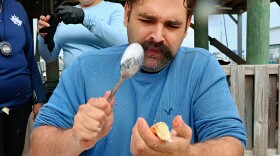RENEE MONTAGNE, host:
This is MORNING EDITION from NPR News. I'm Renee Montagne.
DEBORAH AMOS, host:
And I'm Deborah Amos.
NBC News yesterday became part of the story of the mass shootings at Virginia Tech. The network received what it described as a multimedia manifesto from the gunman, 23-year-old Seung-Hui Cho. According to a time stamp on the package, it was mailed at 9:01 in the morning. That detail is critical to investigators who are trying to piece together a chronology of the events that unfolded on Monday.
NPR's Dina Temple-Raston covers the FBI and has details of the ongoing investigation, and she joins us now. Dina, what exactly did NBC receive yesterday, and what does it mean to the investigation?
DINA TEMPLE-RASTON: Investigators are looking at this big package that they received of 29 photographs and 27 short videos, and 1,800-word diatribe. Cho apparently said that he wanted to get even, but it's still hard to understand with whom.
AMOS: And what have officials pieced together so far?
TEMPLE-RASTON: Well, they're are trying to put together a chronology so that they can figure out what he was doing all day long. They have not yet been able to connect Cho directly to the dormitory shootings that happened at 7:00 in the morning. They have found a trail of bloody footprints in the dorm hallway, but police investigators are unclear if they're actually matched to Cho.
The first attack happened in the advanced hydrology class in Room 206 of the academic building, which was on the other side of campus. There were 13 grad students there. And apparently he just entered and started shooting. They mostly international students, and apparently only four of survived.
He then moved down the hallway to a German class. He came to the front of the class and just started shooting. He was there for about a minute and half, and investigators say he squeezed off about 30 rounds. Then he left, and students blocked the door when he tried to get back in.
AMOS: And did he continue down that hall? That one hallway was where he did all the shooting?
TEMPLE-RASTON: We think so. I haven't been able to ascertain whether or not it's just that one hallway. But it seems that what we know now is that he moved down the hall to a French class. The students there also tried to block the door. They had been hearing these popping sounds and screaming, and started to figure out what was going on. Then he moved down to a computer class, and they managed to keep him out by two sort of burly students actually pushing a desk up against the door and holding it there. He shot through the door and the desk, and they weren't hit. He then moved to where investigators think was his last stop, and that was Room 204, the classroom with the Holocaust survivor, the professor who couldn't lock the door so held himself against it and asked the students to jump to the ground below to try and escape.
AMOS: And what do investigators now know about the weapons that he used?
TEMPLE-RASTON: Well, we're starting to get more details now about where he bought them. He bought the .22 caliber weapon at a pawnshop that was very, very close to school. And he bought ammunition days before the shooting at a Wal-Mart and a local sporting goods store. And we already knew exactly a month before the shooting that he bought this semi-automatic 9mm and a box of 50 cartridges. They actually have that on a video at the gun store.
AMOS: And what are the police focusing on now, what do they need to know? We know who the shooter is and we know a great deal of the details, so what are they looking at now?
TEMPLE-RASTON: Well, it's interesting because this is not really a prosecution. They're not trying to build a case because they already know who the perpetrator is. So what they're trying to do is understand what motivated him and why he did what he did. Why did he go to this dorm that was not his own dorm and start shooting? Did he know someone there? Was he looking for someone in particular when he roamed from classroom to classroom in the academic building? These are all things they hope to learn in the coming days.
AMOS: Thank you very much. NPR's Dina Temple-Raston. Our coverage of the Virginia Tech shootings continues at npr.org, where you can hear a survivor's tale. Transcript provided by NPR, Copyright NPR.









